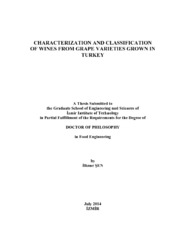Please use this identifier to cite or link to this item:
https://hdl.handle.net/11147/4167Full metadata record
| DC Field | Value | Language |
|---|---|---|
| dc.contributor.advisor | Tokatlı, Figen | - |
| dc.contributor.author | Şen, İlknur | - |
| dc.date.accessioned | 2014-11-17T09:28:00Z | - |
| dc.date.available | 2014-11-17T09:28:00Z | - |
| dc.date.issued | 2014 | - |
| dc.identifier.uri | http://hdl.handle.net/11147/4167 | - |
| dc.description | Thesis (Doctoral)--Izmir Institute of Technology, Food Engineering, Izmir, 2014 | en_US |
| dc.description | Includes bibliographical references (laves: 185-201) | en_US |
| dc.description | Text in English; Abstract: Turkish and English | en_US |
| dc.description.abstract | The wines of Turkish grapes from four vintages (2006-2009) were classified according to variety, geographical origin and vintage based on their chemical composition (element, polyphenol, color, acid, sugar, alcohol, pH, total phenol and brix) by using multivariate statistical techniques. In the varietal classification of red wines, the partial least square-discriminant analysis (PLS-DA) demonstrated the discrimination of Boğazkere-Öküzgözü, Kalecik Karası, Syrah and Cabernet Sauvignon varieties from each other as the significant element, polyphenol, organic acid, sugar and alcohol parameters were combined in the model. Boğazkere and Öküzgözü wines of East Anatolia were characterized with their high coumaroylated anthocyanin derivatives, while Syrah wines of West Anatolia were rich in anthocyanins and flavonols. Kalecik Karası wines were the poorest in terms of total phenol content. In the classification of white wines, Emir wines of Kapadokya region were characterized with their high Li, Sr and resveratrol contents. Sultaniye wines were the lowest in polyphenol content and Muscat wines were the richest in hydroxycinnamic acids. The regional discrimination of red and white wines was achieved with the significant element and polyphenol compositions. The western region wines were characterized with their higher Pb content which may be due to the industrialization of West Anatolia. Moreover, red wines of Tekirdağ region were recognized with their low flavonol-glycoside contents. 2009 vintage red wines were characterized with their high anthocyanin and flavonol contents. In the same way, 2009 vintage white wines had higher flavonols, flavonol-glycosides, phenolic acids and flavan-3-ols. | en_US |
| dc.language.iso | en | en_US |
| dc.publisher | Izmir Institute of Technology | en_US |
| dc.rights | info:eu-repo/semantics/openAccess | en_US |
| dc.subject | Wine | en_US |
| dc.subject.lcsh | Grapes--Turkey | en_US |
| dc.subject.lcsh | Wine and wine making--Turkey | en_US |
| dc.title | Characterization and classification of wines from grape varieties grovn in Turkey | en_US |
| dc.title.alternative | Türkiye'de yetiştirilen üzüm çeşitlerinden üretilen şarapların karakterizasyonu ve sınıflandırılması | en_US |
| dc.type | Doctoral Thesis | en_US |
| dc.department | Thesis (Doctoral)--İzmir Institute of Technology, Food Engineering | en_US |
| dc.relation.publicationcategory | Tez | en_US |
| item.openairetype | Doctoral Thesis | - |
| item.openairecristype | http://purl.org/coar/resource_type/c_18cf | - |
| item.grantfulltext | open | - |
| item.languageiso639-1 | en | - |
| item.cerifentitytype | Publications | - |
| item.fulltext | With Fulltext | - |
| crisitem.author.dept | 03.08. Department of Food Engineering | - |
| Appears in Collections: | Phd Degree / Doktora | |
Files in This Item:
| File | Description | Size | Format | |
|---|---|---|---|---|
| 10013515.pdf | DoctoralThesis | 2.02 MB | Adobe PDF |  View/Open |
CORE Recommender
Page view(s)
186
checked on Aug 5, 2024
Download(s)
434
checked on Aug 5, 2024
Google ScholarTM
Check
Items in GCRIS Repository are protected by copyright, with all rights reserved, unless otherwise indicated.